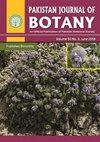Salicylic acid promotes sunflower production under normal and water deficit conditions
IF 0.9
4区 生物学
Q4 PLANT SCIENCES
引用次数: 0
Abstract
Water insufficiency affects agriculture productivity and quality of crops. Applying antioxidants such as salicylic acid (SA) can enhance plant resistivity against drought stress. The current experiment was performed to check the concentration and mode of application of salicylic acid (S.A) under normal and drought stress. A completely randomized design (CRD) with factorial arrangement, one factor being the moisture condition (i.e., normal and drought) and the second one being the application method (foliar spray and seed soaking) was used. The treatments included T1 (control), T2-T4 (0.5mM, 1.0mM, and 1.5mM SA by foliar spray) respectively, and T5-T7 (0.5mM, 1.0mM, and 1.5mM SA by seed soaking), respectively). Under the normal irrigation i.e., at 75% of Water Holding Capacity (WHC), T4 had the highest percentage increase in plant height (56.28%), head diameter (45.65%), shoot fresh weight (56.30%), shoot dry weight (164.94%), root fresh weight (184.66%), root dry weight (159.42%), No. of achene/plant (35.74%), thousand grain weight (65.03%) and seed yield/plant (124.15%), NPK concentration (125%, 61.30% and 28.41%), proline contents (59.18%), chlorophyll contents (41.25%) and oil contents (34.88%) compared to T1. Under the drought (40%WHC), T4 performed better and increased plant height (55.67%), head diameter (44.26%), shoot fresh weight (114.87%), shoot dry weight (179.38%), root fresh weight (134.27%), root dry weight (133.90%, No. of achene/plant (20.49%), thousand grain weight (62.58%) and seed yield/plant (96.02%), NPK concentration (221.30%, 78.16% and 11.91%), proline contents (55.43%), chlorophyll contents (43.68%) and oil contents% (35.04%) compared to T1. The electrolyte leakage (EL%) was reduced by 47.18% at 75WHC and 50.41% at 40%WHC. The results predicted that the application of SA at the 1.5mM(T4) concentration in both moisture conditions and drought showed better performance. The agronomic and biochemical parameters were enhanced by foliar application of SA except the electrolyte leakage which reduces significantly by SA foliar spray. Similarly, the macronutrients (NPK) were enhanced by the foliar application of S.A at 1.5mM dose. Therefore, the foliar application of adequate quantity of SA could be a better strategy to cope with water stress in dry areas where rainfall in low.水杨酸在正常和缺水条件下促进向日葵生产
缺水会影响农业生产率和作物质量。施用水杨酸(SA)等抗氧化剂可以增强植物抵抗干旱胁迫的能力。本实验旨在检测水杨酸(SA)在正常和干旱胁迫下的浓度和施用方式。试验采用了完全随机设计(CRD)的因子排列,一个因子是水分条件(即正常和干旱),第二个因子是施用方法(叶面喷施和浸种)。处理包括 T1(对照)、T2-T4(分别为 0.5mM、1.0mM 和 1.5mM SA 叶面喷施)和 T5-T7(分别为 0.5mM、1.0mM 和 1.5mM SA 种子浸泡)。在正常灌溉条件下,即在正常灌溉条件下,即在持水量(WHC)为 75% 的条件下,T4 的株高(56.28%)、头径(45.65%)、芽鲜重(56.30%)、芽干重(164.94%)、根鲜重(184.66%)、根干重(159.42%)、瘦果数/株(35.74%)、千粒重(65.03%)和种子产量/株(124.15%)、氮磷钾浓度(125%、61.30% 和 28.41%)、脯氨酸含量(59.18%)、叶绿素含量(41.25%)和油脂含量(34.88%)均高于 T1。在干旱(40%WHC)条件下,T4 的表现更好,株高(55.67%)、头径(44.26%)、嫩枝鲜重(114.87%)、嫩枝干重(179.38%)、根鲜重(134.27%)、根干重(133.90%)、瘦果数/株(20)、叶绿素含量(41.25%)和油脂含量(34.88%)均比 T1 增加。在氮磷钾浓度(221.30%、78.16% 和 11.91%)、脯氨酸含量(55.43%)、叶绿素含量(43.68%)和油脂含量(35.04%)方面,与 T1 相比,T1 的差异显著。电解质渗漏率(EL%)在 75WHC 和 40%WHC 条件下分别降低了 47.18% 和 50.41%。结果表明,在水分条件和干旱条件下,施用 1.5mM(T4)浓度的 SA 都有更好的表现。除电解质渗漏因 SA 叶面喷施而显著减少外,其他农艺和生化指标均因 SA 叶面喷施而提高。同样,叶面喷施 1.5mM 剂量的 S.A 也提高了主要营养元素(氮磷钾)的含量。因此,在降雨量较少的干旱地区,叶面喷施足量的 SA 可能是应对水分胁迫的更好策略。
本文章由计算机程序翻译,如有差异,请以英文原文为准。
求助全文
约1分钟内获得全文
求助全文
来源期刊

Pakistan Journal of Botany
生物-植物科学
CiteScore
2.40
自引率
8.30%
发文量
218
审稿时长
8.4 months
期刊介绍:
The Pakistan Journal of Botany is an international journal for publication of original research in plant science. Work on all plant groups, including fossil plants, is published. The journal publishes in the areas of: ecology and ecophysiology; conservation biology and biodiversity; forest biology and management; cell and molecular biology; paleobotany; reproductive biology and genetics; mycology and pathology; and structure and development.
 求助内容:
求助内容: 应助结果提醒方式:
应助结果提醒方式:


